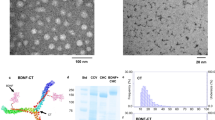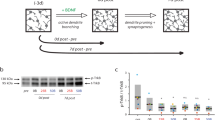Abstract
To directly compare biological activities of the neurotrophins NT4 and BDNF in vivo, we replaced the BDNF coding sequence with the NT4 sequence in mice (Bdnfnt4-ki). Mice expressing NT4 in place of BDNF were viable, in contrast with BDNF null mutants, which die shortly after birth. Although the Bdnfnt4-ki/nt4-ki and wild-type Bdnf+/+ alleles yielded similar levels of NT4 and BDNF proteins, NT4 supported more sensory neurons than BDNF and promoted functional synapse formation in cultured hippocampal neurons. Homozygous Bdnfnt4-ki/nt4-ki mice showed reduced body weight, infertility and skin lesions, suggesting unique biological activities of NT4 in vivo. The distinct activities of NT4 and BDNF may result partly from differential activation of the TrkB receptor and its down-stream signals.
This is a preview of subscription content, access via your institution
Access options
Subscribe to this journal
Receive 12 print issues and online access
209,00 € per year
only 17,42 € per issue
Buy this article
- Purchase on SpringerLink
- Instant access to full article PDF
Prices may be subject to local taxes which are calculated during checkout




Similar content being viewed by others
References
Lewin, G. R. & Barde, Y. A. Physiology of the neurotrophins. Annu. Rev. Neurosci. 19, 289–317 (1996).
McAllister, A. K., Katz, L. C. & Lo, D. C. Neurotrophins and synaptic plasticity. Annu. Rev. Neurosci. 22, 295–318 (1999).
Levi-Montalcini, R. The nerve growth factor 35 years later. Science 237, 1154–1162 (1987).
Leibrock, J. et al. Molecular cloning and expression of brain-derived neurotrophic factor. Nature 341, 149–152 (1989).
Hohn, A., Leibrock, J., Bailey, K. & Barde, Y. A. Identification and characterization of a novel member of the nerve growth factor/brain-derived neurotrophic factor family. Nature 344, 339–341 (1990).
Maisonpierre, P. C. et al. Neurotrophin-3: a neurotrophic factor related to NGF and BDNF. Science 247, 1446–1451 (1990).
Rosenthal, A. et al. Primary structure and biological activity of a novel human neurotrophic factor. Neuron 4, 767–773 (1990).
Ernfors, P., Ibanez, C. F., Ebendal, T., Olson, L. & Persson, H. Molecular cloning and neurotrophic activities of a protein with structural similarities to nerve growth factor: developmental and topographical expression in the brain. Proc. Natl. Acad. Sci. USA 87, 5454–5458 (1990).
Jones, K. R. & Reichardt, L. F. Molecular cloning of a human gene that is a member of the nerve growth factor family. Proc. Natl. Acad. Sci. USA 87, 8060–8064 (1990).
Berkemeier, L. R. et al. Neurotrophin-5: a novel neurotrophic factor that activates trk and trkB. Neuron 7, 857–866 (1991).
Ip, N. Y. et al. Mammalian neurotrophin-4: structure, chromosomal localization, tissue distribution, and receptor specificity. Proc. Natl. Acad. Sci. USA 89, 3060–3064 (1992).
Barbacid, M. The Trk family of neurotrophin receptors. J. Neurobiol. 25, 1386–1403 (1994).
Bothwell, M. Functional interactions of neurotrophins and neurotrophin receptors. Annu. Rev. Neurosci. 18, 223–253 (1995).
Snider, W. D. Functions of the neurotrophins during nervous system development: what the knockouts are teaching us. Cell 77, 627–638 (1994).
Klein, R. et al. The trkB tyrosine protein kinase is a receptor for brain-derived neurotrophic factor and neurotrophin-3. Cell 66, 395–403 (1991).
Klein, R., Lamballe, F., Bryant, S. & Barbacid, M. The trkB tyrosine protein kinase is a receptor for neurotrophin-4. Neuron 8, 947–956 (1992).
Chao, M. V. The p75 neurotrophin receptor. J. Neurobiol. 25, 1373–1385 (1994).
Davies, A. M., Lee, K. F. & Jaenisch, R. p75-deficient trigeminal sensory neurons have an altered response to NGF but not to other neurotrophins. Neuron 11, 565–574 (1993).
Ibanez, C. F. Neurotrophin-4: the odd one out in the neurotrophin family. Neurochem. Res. 21, 787–793 (1996).
Liu, X., Ernfors, P., Wu, H. & Jaenisch, R. Sensory but not motor neuron deficits in mice lacking NT4 and BDNF. Nature 375, 238–241 (1995).
Conover, J. C. et al. Neuronal deficits, not involving motor neurons, in mice lacking BDNF and/or NT4. Nature 375, 235–238 (1995).
Ernfors, P., Lee, K. F. & Jaenisch, R. Mice lacking brain-derived neurotrophic factor develop with sensory deficits. Nature 368, 147–150 (1994).
Jones, K. R., Farinas, I., Backus, C. & Reichardt, L. F. Targeted disruption of the BDNF gene perturbs brain and sensory neuron development but not motor neuron development. Cell 76, 989–999 (1994).
Bibel, M., Hoppe, E. & Barde, Y. A. Biochemical and functional interactions between the neurotrophin receptors trk and p75NTR. EMBO. J. 18, 616–622 (1999).
Erickson, J. et al. Mice lacking brain-derived neurotrophic factor exhibit visceral sensory neuron losses distinct from mice lacking NT4 and display a severe developmental deficit in control of breathing. J. Neurosci. 16, p5361–5371 (1996)
ElShamy, W. M. & Ernfors, P. Brain-derived neurotrophic factor, neurotrophin-3, and neurotrophin-4 complement and cooperate with each other sequentially during visceral neuron development. J. Neurosci. 17, 8667–8675 (1997).
Bianchi, L. M. et al. Degeneration of vestibular neurons in late embryogenesis of both heterozygous and homozygous BDNF null mutant mice. Development 122, 1965–1973 (1996).
Schwartz, P. M., Borghesani, P. R., Levy, R. L., Pomeroy, S. L. & Segal, R. A. Abnormal cerebellar development and foliation in BDNF−/− mice reveals a role for neurotrophins in CNS patterning. Neuron 19, 269–281 (1997).
Korte, M. et al. Hippocampal long-term potentiation is impaired in mice lacking brain-derived neurotrophic factor. Proc. Natl. Acad. Sci. USA 92, 8856–8860 (1995).
Patterson, S. L. et al. Recombinant BDNF rescues deficits in basal synaptic transmission and hippocampal LTP in BDNF knockout mice. Neuron 16, 1137–1145 (1996).
Pozzo-Miller, L. D. et al. Impairments in high-frequency transmission, synaptic vesicle docking, and synaptic protein distribution in the hippocampus of BDNF knockout mice. J. Neurosci. 19, 4972–4983 (1999).
Fletcher, T. L., De Camilli, P. & Banker, G. Synaptogenesis in hippocampal cultures: evidence indicating that axons and dendrites become competent to form synapses at different stages of neuronal development. J. Neurosci. 14, 6695–6706 (1994).
Ryan, T. A. et al. The kinetics of synaptic vesicle recycling measured at single presynaptic boutons. Neuron 11, 713–724 (1993).
Minichiello, L. et al. Point mutation in trkB causes loss of NT4-dependent neurons without major effects on diverse BDNF responses. Neuron 21, 335–345 (1998).
Ghosh, A., Carnahan, J. & Greenberg, M. E. Requirement for BDNF in activity-dependent survival of cortical neurons. Science 263, 1618–1623 (1994).
Segal, R. & Greenberg, M.E. Intracellular signaling pathways activated by neurotrophic factors. Ann. Rev. Neurosci. 19, 463–489 (1996).
Ryden, M. et al. Functional analysis of mutant neurotrophins deficient in low-affinity binding reveals a role for p75LNGFR in NT-4 signalling. EMBO. J. 14, 1979–1990 (1995).
Curtis, R. et al. Differential role of the low affinity neurotrophin receptor (p75) in retrograde axonal transport of the neurotrophins. Neuron 14, 1201–1211 (1995).
Fan, G., Jaenisch, R. & Kucera, J. Arole for p75 receptor in neurotrophin-3 functioning during the development of limb proprioception. Neuroscience 90, 259–268 (1999).
Strohmaier, C., Carter, B., Urfer, R., Barde, Y. & Dechant, G. A splice variant of the neurotrophin receptor trkB with increased specificity for brain-derived neurotrophic factor. EMBO J. 15, 3332–3337 (1996).
Vicario-Abejon, C., Collin, C., McKay, R. D. & Segal, M. Neurotrophins induce formation of functional excitatory and inhibitory synapses between cultured hippocampal neurons. J. Neurosci. 18, 7256–7271 (1998).
Lyons, W. E. et al. Brain-derived neurotrophic factor-deficient mice develop aggressiveness and hyperphagia in conjunction with brain serotonergic abnormalities. Proc. Natl. Acad. Sci. USA 96, 15239–15244 (1999)
Stucky, C., De, C. T., Lindsay, R., Yancopoulos, G. & Koltzenburg, M. Neurotrophin 4 is required for the survival of a subclass of hair follicle receptors. J. Neurosci. 18, 7040–7046 (1998).
Carroll, P., Lewin, G. R., Koltzenburg, M., Toyka, K. V. & Thoenen, H. A role for BDNF in mechanosensation. Nat. Neurosci. 1, 42–46 (1998).
McAllister, A. K., Lo, D. C. & Katz, L. C. Neurotrophins regulate dendritic growth in developing visual cortex. Neuron 15, 791–803 (1995).
Hyman, C. et al. Overlapping and distinct actions of the neurotrophins BDNF, NT-3, and NT-4/5 on cultured dopaminergic and GABAergic neurons of the ventral mesencephalon. J. Neurosci. 14, 335–347 (1994).
Fischer, W., Sirevaag, A., Wiegand, S. J., Lindsay, R. M. & Bjorklund, A. Reversal of spatial memory impairments in aged rats by nerve growth factor and neurotrophins 3 and 4/5 but not by brain-derived neurotrophic factor. Proc. Natl. Acad. Sci. USA 91, 8607–8611 (1994).
Brunstrom, J. E., Gray-Swain, M. R., Osborne, P. A. & Pearlman, A. L. Neuronal heterotopias in the developing cerebral cortex produced by neurotrophin-4. Neuron 18, 505–517 (1997).
Liu, G. & Tsien, R. W. Properties of synaptic transmission at single hippocampal synaptic boutons. Nature 375, 404–408 (1995).
Bonni, A. et al. Regulation of gliogenesis in the central nervous system by the JAK-STAT signaling pathway. Science 278, 477–483 (1997).
Acknowledgements
We would like to thank Brian Bates, Jeffrey Cottrell, Scott Waddell and Michael Greenberg for reading the manuscript. We appreciate the technical support from Jesse Dausemann, Ruth Curry and Jeanne Reis. This work was supported by NIH grants (R.J. and G.L.), Deutsche Forschungsgemeinschaft and the European Union (R.K.), a Medical Foundation Postdoctoral Fellowship (G.F.), and RIKEN-MIT fellowships (C.E. and J.J.R.).
Author information
Authors and Affiliations
Corresponding author
Rights and permissions
About this article
Cite this article
Fan, G., Egles, C., Sun, Y. et al. Knocking the NT4 gene into the BDNF locus rescues BDNF deficient mice and reveals distinct NT4 and BDNF activities. Nat Neurosci 3, 350–357 (2000). https://doi.org/10.1038/73921
Received:
Accepted:
Issue Date:
DOI: https://doi.org/10.1038/73921
This article is cited by
-
Glial cells modulate retinal cell survival in rotenone-induced neural degeneration
Scientific Reports (2021)
-
Therapeutic Potential of a Combination of Electroacupuncture and TrkB-Expressing Mesenchymal Stem Cells for Ischemic Stroke
Molecular Neurobiology (2019)
-
TrkB Signaling in Dorsal Raphe Nucleus is Essential for Antidepressant Efficacy and Normal Aggression Behavior
Neuropsychopharmacology (2017)
-
Neurotrophin Signaling and Stem Cells—Implications for Neurodegenerative Diseases and Stem Cell Therapy
Molecular Neurobiology (2017)
-
Genetic dissection of TrkB activated signalling pathways required for specific aspects of the taste system
Neural Development (2014)



